- Elasticsearch Guide: other versions:
- What is Elasticsearch?
- What’s new in 7.14
- Quick start
- Set up Elasticsearch
- Installing Elasticsearch
- Configuring Elasticsearch
- Important Elasticsearch configuration
- Secure settings
- Auditing settings
- Circuit breaker settings
- Cluster-level shard allocation and routing settings
- Cross-cluster replication settings
- Discovery and cluster formation settings
- Field data cache settings
- Index lifecycle management settings
- Index management settings
- Index recovery settings
- Indexing buffer settings
- License settings
- Local gateway settings
- Logging
- Machine learning settings
- Monitoring settings
- Node
- Networking
- Node query cache settings
- Search settings
- Security settings
- Shard request cache settings
- Snapshot lifecycle management settings
- Transforms settings
- Thread pools
- Watcher settings
- Advanced configuration
- Important System Configuration
- Bootstrap Checks
- Heap size check
- File descriptor check
- Memory lock check
- Maximum number of threads check
- Max file size check
- Maximum size virtual memory check
- Maximum map count check
- Client JVM check
- Use serial collector check
- System call filter check
- OnError and OnOutOfMemoryError checks
- Early-access check
- G1GC check
- All permission check
- Discovery configuration check
- Bootstrap Checks for X-Pack
- Starting Elasticsearch
- Stopping Elasticsearch
- Discovery and cluster formation
- Add and remove nodes in your cluster
- Full-cluster restart and rolling restart
- Remote clusters
- Set up X-Pack
- Configuring X-Pack Java Clients
- Plugins
- Upgrade Elasticsearch
- Index modules
- Mapping
- Text analysis
- Overview
- Concepts
- Configure text analysis
- Built-in analyzer reference
- Tokenizer reference
- Token filter reference
- Apostrophe
- ASCII folding
- CJK bigram
- CJK width
- Classic
- Common grams
- Conditional
- Decimal digit
- Delimited payload
- Dictionary decompounder
- Edge n-gram
- Elision
- Fingerprint
- Flatten graph
- Hunspell
- Hyphenation decompounder
- Keep types
- Keep words
- Keyword marker
- Keyword repeat
- KStem
- Length
- Limit token count
- Lowercase
- MinHash
- Multiplexer
- N-gram
- Normalization
- Pattern capture
- Pattern replace
- Phonetic
- Porter stem
- Predicate script
- Remove duplicates
- Reverse
- Shingle
- Snowball
- Stemmer
- Stemmer override
- Stop
- Synonym
- Synonym graph
- Trim
- Truncate
- Unique
- Uppercase
- Word delimiter
- Word delimiter graph
- Character filters reference
- Normalizers
- Index templates
- Data streams
- Ingest pipelines
- Example: Parse logs
- Enrich your data
- Processor reference
- Append
- Bytes
- Circle
- Community ID
- Convert
- CSV
- Date
- Date index name
- Dissect
- Dot expander
- Drop
- Enrich
- Fail
- Fingerprint
- Foreach
- GeoIP
- Grok
- Gsub
- HTML strip
- Inference
- Join
- JSON
- KV
- Lowercase
- Network direction
- Pipeline
- Registered domain
- Remove
- Rename
- Script
- Set
- Set security user
- Sort
- Split
- Trim
- Uppercase
- URL decode
- URI parts
- User agent
- Aliases
- Search your data
- Query DSL
- Aggregations
- Bucket aggregations
- Adjacency matrix
- Auto-interval date histogram
- Children
- Composite
- Date histogram
- Date range
- Diversified sampler
- Filter
- Filters
- Geo-distance
- Geohash grid
- Geotile grid
- Global
- Histogram
- IP range
- Missing
- Multi Terms
- Nested
- Parent
- Range
- Rare terms
- Reverse nested
- Sampler
- Significant terms
- Significant text
- Terms
- Variable width histogram
- Subtleties of bucketing range fields
- Metrics aggregations
- Pipeline aggregations
- Average bucket
- Bucket script
- Bucket count K-S test
- Bucket correlation
- Bucket selector
- Bucket sort
- Cumulative cardinality
- Cumulative sum
- Derivative
- Extended stats bucket
- Inference bucket
- Max bucket
- Min bucket
- Moving average
- Moving function
- Moving percentiles
- Normalize
- Percentiles bucket
- Serial differencing
- Stats bucket
- Sum bucket
- Bucket aggregations
- EQL
- SQL
- Overview
- Getting Started with SQL
- Conventions and Terminology
- Security
- SQL REST API
- SQL Translate API
- SQL CLI
- SQL JDBC
- SQL ODBC
- SQL Client Applications
- SQL Language
- Functions and Operators
- Comparison Operators
- Logical Operators
- Math Operators
- Cast Operators
- LIKE and RLIKE Operators
- Aggregate Functions
- Grouping Functions
- Date/Time and Interval Functions and Operators
- Full-Text Search Functions
- Mathematical Functions
- String Functions
- Type Conversion Functions
- Geo Functions
- Conditional Functions And Expressions
- System Functions
- Reserved keywords
- SQL Limitations
- Scripting
- Data management
- ILM: Manage the index lifecycle
- Overview
- Concepts
- Automate rollover
- Customize built-in ILM policies
- Index lifecycle actions
- Configure a lifecycle policy
- Migrate index allocation filters to node roles
- Troubleshooting index lifecycle management errors
- Start and stop index lifecycle management
- Manage existing indices
- Skip rollover
- Restore a managed data stream or index
- Autoscaling
- Monitor a cluster
- Roll up or transform your data
- Set up a cluster for high availability
- Snapshot and restore
- Secure the Elastic Stack
- Elasticsearch security principles
- Configuring security
- Updating node security certificates
- User authentication
- Built-in users
- Service accounts
- Internal users
- Token-based authentication services
- Realms
- Realm chains
- Active Directory user authentication
- File-based user authentication
- LDAP user authentication
- Native user authentication
- OpenID Connect authentication
- PKI user authentication
- SAML authentication
- Kerberos authentication
- Integrating with other authentication systems
- Enabling anonymous access
- Controlling the user cache
- Configuring SAML single-sign-on on the Elastic Stack
- Configuring single sign-on to the Elastic Stack using OpenID Connect
- User authorization
- Built-in roles
- Defining roles
- Granting access to Stack Management features
- Security privileges
- Document level security
- Field level security
- Granting privileges for data streams and aliases
- Mapping users and groups to roles
- Setting up field and document level security
- Submitting requests on behalf of other users
- Configuring authorization delegation
- Customizing roles and authorization
- Enable audit logging
- Restricting connections with IP filtering
- Cross cluster search, clients, and integrations
- Operator privileges
- Troubleshooting
- Some settings are not returned via the nodes settings API
- Authorization exceptions
- Users command fails due to extra arguments
- Users are frequently locked out of Active Directory
- Certificate verification fails for curl on Mac
- SSLHandshakeException causes connections to fail
- Common SSL/TLS exceptions
- Common Kerberos exceptions
- Common SAML issues
- Internal Server Error in Kibana
- Setup-passwords command fails due to connection failure
- Failures due to relocation of the configuration files
- Limitations
- Watcher
- Command line tools
- How to
- REST APIs
- API conventions
- Autoscaling APIs
- Compact and aligned text (CAT) APIs
- cat aliases
- cat allocation
- cat anomaly detectors
- cat count
- cat data frame analytics
- cat datafeeds
- cat fielddata
- cat health
- cat indices
- cat master
- cat nodeattrs
- cat nodes
- cat pending tasks
- cat plugins
- cat recovery
- cat repositories
- cat segments
- cat shards
- cat snapshots
- cat task management
- cat templates
- cat thread pool
- cat trained model
- cat transforms
- Cluster APIs
- Cluster allocation explain
- Cluster get settings
- Cluster health
- Cluster reroute
- Cluster state
- Cluster stats
- Cluster update settings
- Nodes feature usage
- Nodes hot threads
- Nodes info
- Nodes reload secure settings
- Nodes stats
- Pending cluster tasks
- Remote cluster info
- Task management
- Voting configuration exclusions
- Cross-cluster replication APIs
- Data stream APIs
- Document APIs
- Enrich APIs
- EQL APIs
- Features APIs
- Fleet APIs
- Find structure API
- Graph explore API
- Index APIs
- Alias exists
- Aliases
- Analyze
- Clear cache
- Clone index
- Close index
- Create index
- Create or update alias
- Create or update component template
- Create or update index template
- Create or update index template (legacy)
- Delete component template
- Delete dangling index
- Delete alias
- Delete index
- Delete index template
- Delete index template (legacy)
- Exists
- Flush
- Force merge
- Freeze index
- Get alias
- Get component template
- Get field mapping
- Get index
- Get index settings
- Get index template
- Get index template (legacy)
- Get mapping
- Import dangling index
- Index recovery
- Index segments
- Index shard stores
- Index stats
- Index template exists (legacy)
- List dangling indices
- Open index
- Refresh
- Resolve index
- Rollover
- Shrink index
- Simulate index
- Simulate template
- Split index
- Synced flush
- Type exists
- Unfreeze index
- Update index settings
- Update mapping
- Index lifecycle management APIs
- Ingest APIs
- Info API
- Licensing APIs
- Logstash APIs
- Machine learning anomaly detection APIs
- Add events to calendar
- Add jobs to calendar
- Close jobs
- Create jobs
- Create calendars
- Create datafeeds
- Create filters
- Delete calendars
- Delete datafeeds
- Delete events from calendar
- Delete filters
- Delete forecasts
- Delete jobs
- Delete jobs from calendar
- Delete model snapshots
- Delete expired data
- Estimate model memory
- Find file structure
- Flush jobs
- Forecast jobs
- Get buckets
- Get calendars
- Get categories
- Get datafeeds
- Get datafeed statistics
- Get influencers
- Get jobs
- Get job statistics
- Get machine learning info
- Get model snapshots
- Get overall buckets
- Get scheduled events
- Get filters
- Get records
- Open jobs
- Post data to jobs
- Preview datafeeds
- Reset jobs
- Revert model snapshots
- Set upgrade mode
- Start datafeeds
- Stop datafeeds
- Update datafeeds
- Update filters
- Update jobs
- Update model snapshots
- Upgrade model snapshots
- Machine learning data frame analytics APIs
- Create data frame analytics jobs
- Create or update trained model aliases
- Create trained models
- Update data frame analytics jobs
- Delete data frame analytics jobs
- Delete trained models
- Delete trained model aliases
- Evaluate data frame analytics
- Explain data frame analytics
- Get data frame analytics jobs
- Get data frame analytics jobs stats
- Get trained models
- Get trained models stats
- Preview data frame analytics
- Start data frame analytics jobs
- Stop data frame analytics jobs
- Migration APIs
- Reload search analyzers API
- Repositories metering APIs
- Rollup APIs
- Script APIs
- Search APIs
- Searchable snapshots APIs
- Security APIs
- Authenticate
- Change passwords
- Clear cache
- Clear roles cache
- Clear privileges cache
- Clear API key cache
- Clear service account token caches
- Create API keys
- Create or update application privileges
- Create or update role mappings
- Create or update roles
- Create or update users
- Create service account tokens
- Delegate PKI authentication
- Delete application privileges
- Delete role mappings
- Delete roles
- Delete service account token
- Delete users
- Disable users
- Enable users
- Get API key information
- Get application privileges
- Get builtin privileges
- Get role mappings
- Get roles
- Get service accounts
- Get service account credentials
- Get token
- Get user privileges
- Get users
- Grant API keys
- Has privileges
- Invalidate API key
- Invalidate token
- OpenID Connect prepare authentication
- OpenID Connect authenticate
- OpenID Connect logout
- SAML prepare authentication
- SAML authenticate
- SAML logout
- SAML invalidate
- SAML complete logout
- SAML service provider metadata
- SSL certificate
- Snapshot and restore APIs
- Snapshot lifecycle management APIs
- SQL APIs
- Transform APIs
- Usage API
- Watcher APIs
- Definitions
- Migration guide
- Release notes
- Elasticsearch version 7.14.2
- Elasticsearch version 7.14.1
- Elasticsearch version 7.14.0
- Elasticsearch version 7.13.4
- Elasticsearch version 7.13.3
- Elasticsearch version 7.13.2
- Elasticsearch version 7.13.1
- Elasticsearch version 7.13.0
- Elasticsearch version 7.12.1
- Elasticsearch version 7.12.0
- Elasticsearch version 7.11.2
- Elasticsearch version 7.11.1
- Elasticsearch version 7.11.0
- Elasticsearch version 7.10.2
- Elasticsearch version 7.10.1
- Elasticsearch version 7.10.0
- Elasticsearch version 7.9.3
- Elasticsearch version 7.9.2
- Elasticsearch version 7.9.1
- Elasticsearch version 7.9.0
- Elasticsearch version 7.8.1
- Elasticsearch version 7.8.0
- Elasticsearch version 7.7.1
- Elasticsearch version 7.7.0
- Elasticsearch version 7.6.2
- Elasticsearch version 7.6.1
- Elasticsearch version 7.6.0
- Elasticsearch version 7.5.2
- Elasticsearch version 7.5.1
- Elasticsearch version 7.5.0
- Elasticsearch version 7.4.2
- Elasticsearch version 7.4.1
- Elasticsearch version 7.4.0
- Elasticsearch version 7.3.2
- Elasticsearch version 7.3.1
- Elasticsearch version 7.3.0
- Elasticsearch version 7.2.1
- Elasticsearch version 7.2.0
- Elasticsearch version 7.1.1
- Elasticsearch version 7.1.0
- Elasticsearch version 7.0.0
- Elasticsearch version 7.0.0-rc2
- Elasticsearch version 7.0.0-rc1
- Elasticsearch version 7.0.0-beta1
- Elasticsearch version 7.0.0-alpha2
- Elasticsearch version 7.0.0-alpha1
- Dependencies and versions
Install Elasticsearch with Windows MSI Installer
editInstall Elasticsearch with Windows MSI Installer
editThis functionality is in beta and is subject to change. The design and code is less mature than official GA features and is being provided as-is with no warranties. Beta features are not subject to the support SLA of official GA features.
Elasticsearch can be installed on Windows using the .msi package. This can
install Elasticsearch as a Windows service or allow it to be run manually using
the included elasticsearch.exe executable.
Elasticsearch has historically been installed on Windows using the .zip archive.
You can continue using the .zip approach if you prefer.
This package contains both free and subscription features. Start a 30-day trial to try out all of the features.
On Windows the Elasticsearch machine learning feature requires the Microsoft Universal C Runtime library. This is built into Windows 10, Windows Server 2016 and more recent versions of Windows. For older versions of Windows it can be installed via Windows Update, or from a separate download. If you cannot install the Microsoft Universal C Runtime library you can still use the rest of Elasticsearch if you disable the machine learning feature.
The latest stable version of Elasticsearch can be found on the Download Elasticsearch page. Other versions can be found on the Past Releases page.
Elasticsearch includes a bundled version of OpenJDK from the JDK maintainers (GPLv2+CE). To use your own version of Java, see the JVM version requirements
Download the .msi package
editDownload the .msi package for Elasticsearch v7.14.2 from https://artifacts.elastic.co/downloads/elasticsearch/elasticsearch-7.14.2.msi
Install using the graphical user interface (GUI)
editDouble-click the downloaded .msi package to launch a GUI wizard that will guide you through the
installation process. You can view help on any step by clicking the ? button, which reveals an
aside panel with additional information for each input:
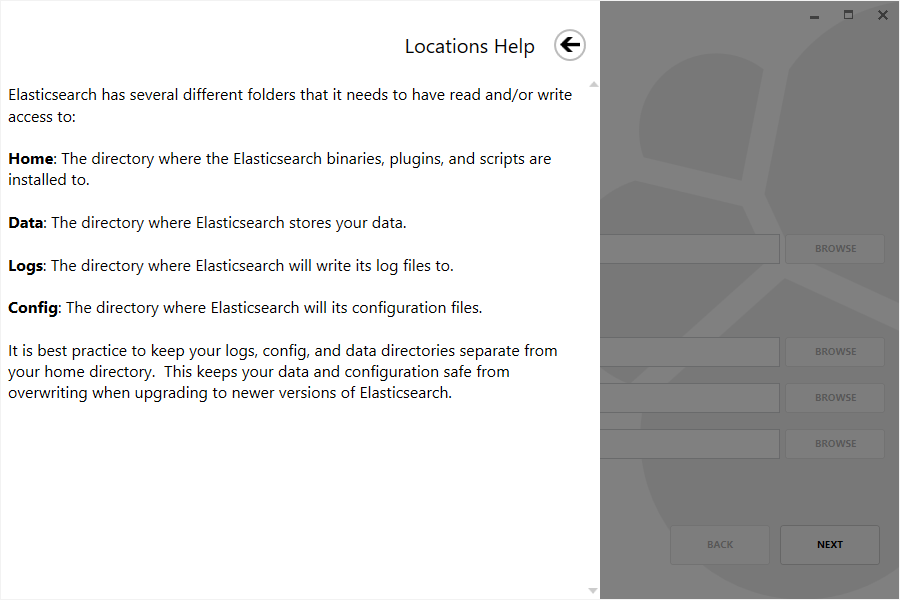
Within the first screen, select the directory for the installation. In addition, select directories for where data, logs and configuration will be placed or use the default locations:
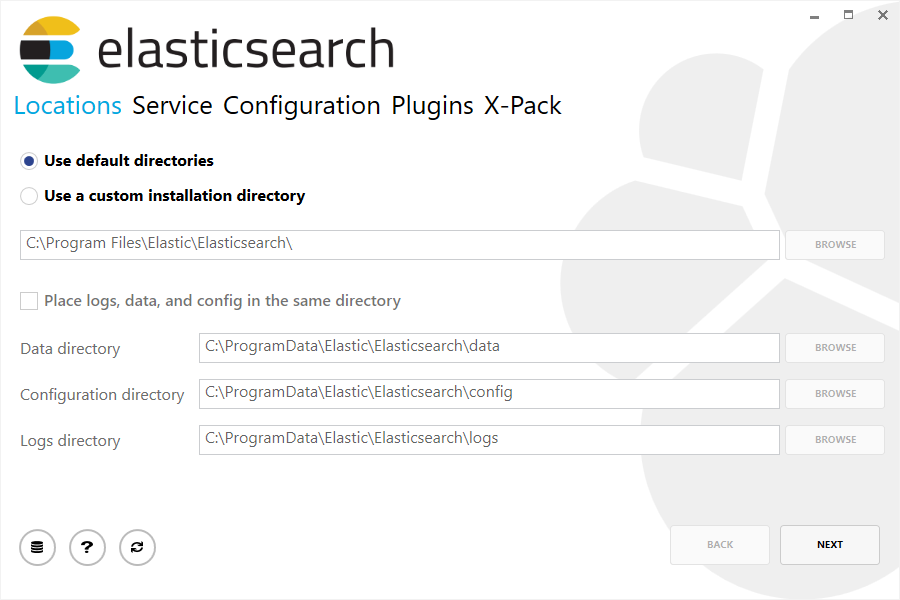
Then select whether to install as a service or start Elasticsearch manually as needed. When installing as a service, you can also configure the Windows account to run the service with, whether the service should be started after installation and the Windows startup behaviour:
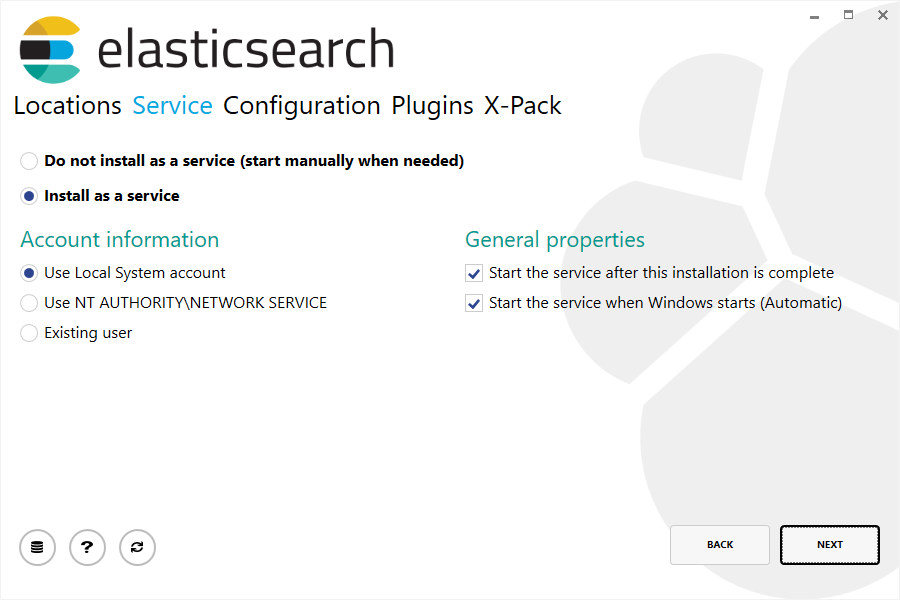
When selecting a Windows account to run the service with, be sure that the chosen account has sufficient privileges to access the installation and other deployment directories chosen. Also ensure the account is able to run Windows services.
Common configuration settings are exposed within the Configuration section, allowing the cluster name, node name and roles to be set, in addition to memory and network settings:
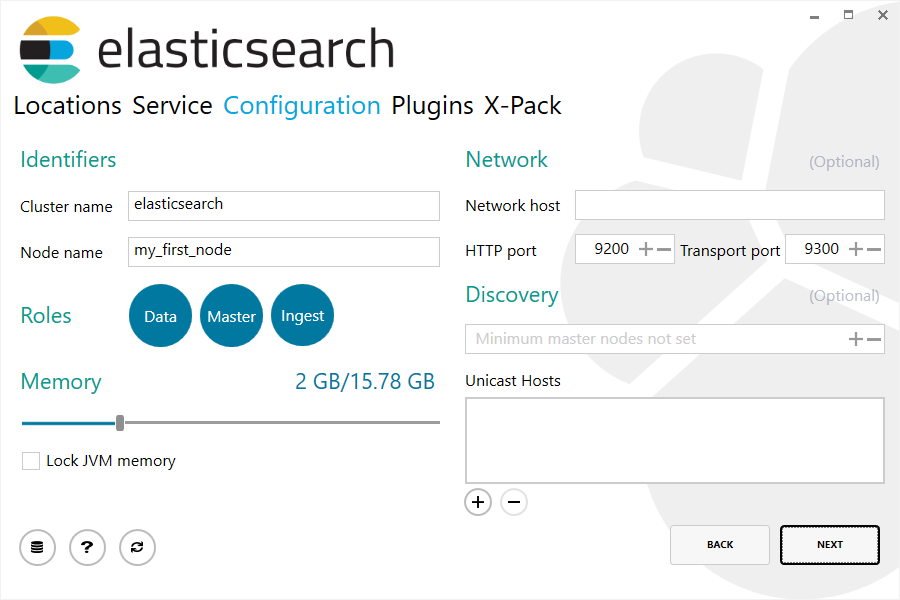
A list of common plugins that can be downloaded and installed as part of the installation, with the option to configure an HTTPS proxy through which to download these plugins.
Ensure the installation machine has access to the internet and that any corporate firewalls in place are configured to allow downloads from artifacts.elastic.co:
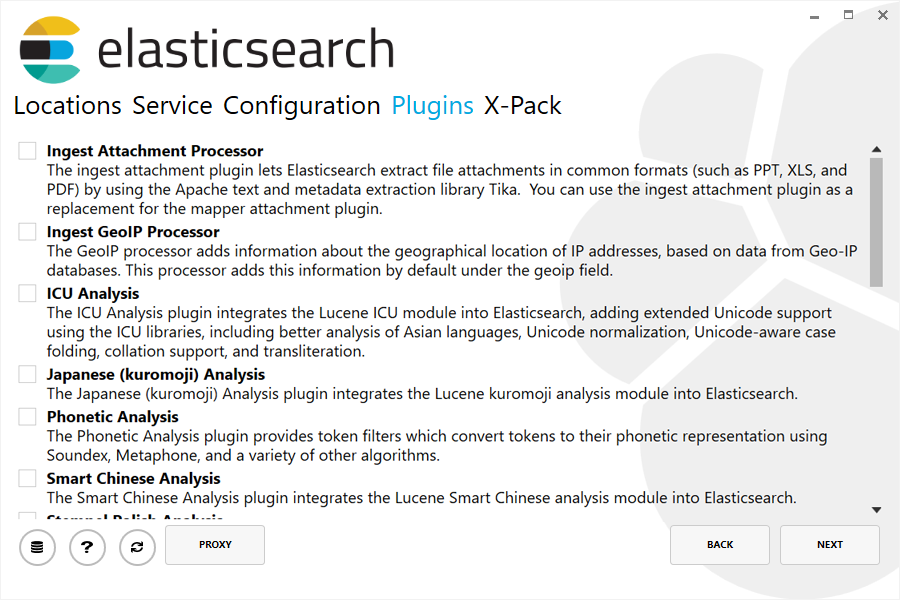
As of version 6.3.0, X-Pack is now bundled by default. The final step allows a choice of the type of license to install, in addition to security configuration and built-in user configuration:
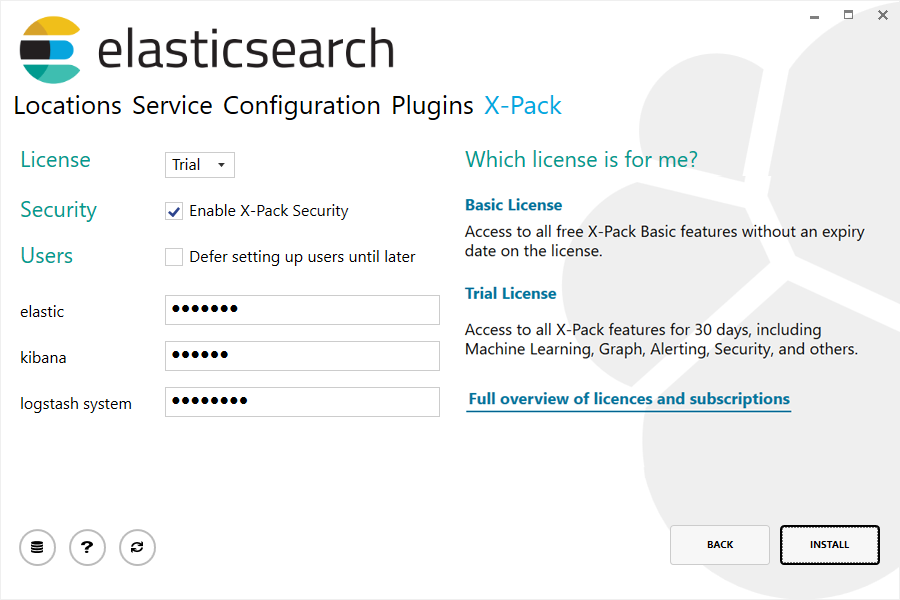
After clicking the install button, the installation will begin:
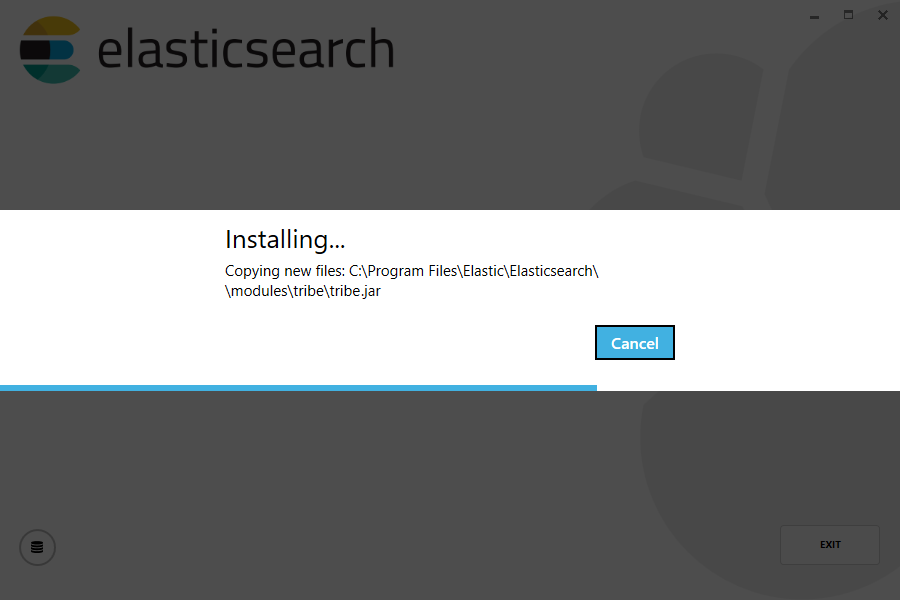
…and will indicate when it has been successfully installed:
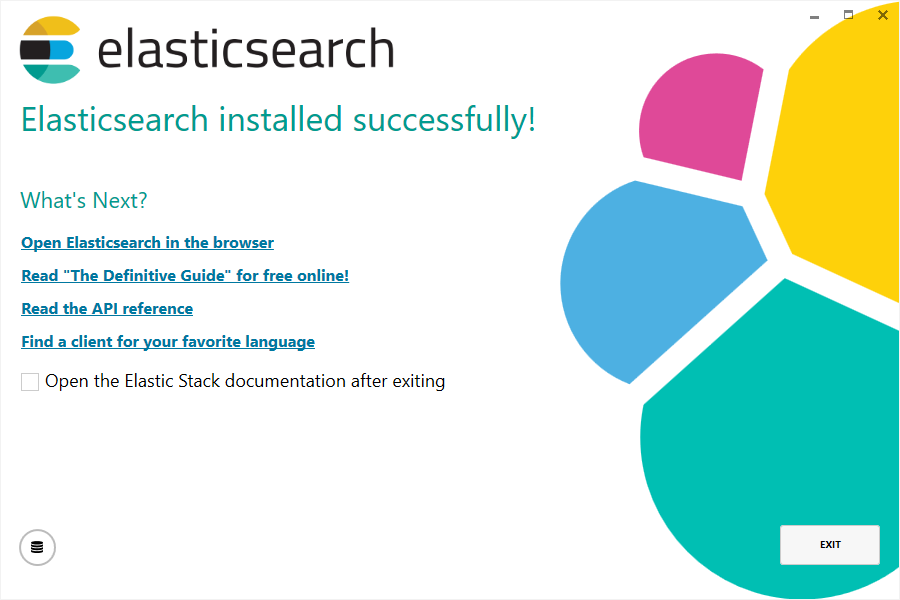
Install using the command line
editThe .msi can also install Elasticsearch using the command line. The simplest installation
using the same defaults as the GUI is achieved by first navigating to the download directory,
then running:
msiexec.exe /i elasticsearch-7.14.2.msi /qn
By default, msiexec.exe does not wait for the installation process to complete, since it runs in the
Windows subsystem. To wait on the process to finish and ensure that %ERRORLEVEL% is set
accordingly, it is recommended to use start /wait to create a process and wait for it to exit
start /wait msiexec.exe /i elasticsearch-7.14.2.msi /qn
As with any MSI installation package, a log file for the installation process can be found
within the %TEMP% directory, with a randomly generated name adhering to the format
MSI<random>.LOG. The path to a log file can be supplied using the /l command line argument
start /wait msiexec.exe /i elasticsearch-7.14.2.msi /qn /l install.log
Supported Windows Installer command line arguments can be viewed using
msiexec.exe /help
…or by consulting the Windows Installer SDK Command-Line Options.
Command line options
editAll settings exposed within the GUI are also available as command line arguments (referred to
as properties within Windows Installer documentation) that can be passed to msiexec.exe:
|
|
The installation directory. The final directory in the path must
be the version of Elasticsearch.
Defaults to |
|
|
The directory in which to store your data.
Defaults to |
|
|
The directory in which to store your configuration.
Defaults to |
|
|
The directory in which to store your logs.
Defaults to |
|
|
Whether the data, configuration and logs directories
should be created under the installation directory. Defaults to |
|
|
Whether Elasticsearch is installed and configured as a Windows Service.
Defaults to |
|
|
Whether the Windows Service is started after installation finishes.
Defaults to |
|
|
Whether the Windows Service is started when Windows is started.
Defaults to |
|
|
Whether the Windows service runs under the LocalSystem Account.
Defaults to |
|
|
Whether the Windows service runs under the NetworkService Account. Defaults
to |
|
|
Whether the Windows service runs under a specified existing account. Defaults
to |
|
|
The username for the account under which the Windows service runs. Defaults to |
|
|
The password for the account under which the Windows service runs. Defaults to |
|
|
The name of the cluster. Defaults to |
|
|
The name of the node. Defaults to |
|
|
Whether Elasticsearch is configured as a master node. Defaults to |
|
|
Whether Elasticsearch is configured as a data node. Defaults to |
|
|
Whether Elasticsearch is configured as an ingest node. Defaults to |
|
|
The amount of memory to allocate to the JVM heap for Elasticsearch.
Defaults to |
|
|
Whether |
|
|
A comma separated list of hosts in the form |
|
|
The minimum number of master-eligible nodes that must be visible
in order to form a cluster. Defaults to |
|
|
The hostname or IP address to bind the node to and publish (advertise) this
host to other nodes in the cluster. Defaults to |
|
|
The port to use for exposing Elasticsearch APIs over HTTP. Defaults to |
|
|
The port to use for internal communication between nodes within the cluster.
Defaults to |
|
|
A comma separated list of the plugins to download and install as part of the
installation. Defaults to |
|
|
The proxy host to use to download plugins over HTTPS. Defaults to |
|
|
The proxy port to use to download plugins over HTTPS. Defaults to |
|
|
The proxy host to use to download plugins over HTTP. Defaults to |
|
|
The proxy port to use to download plugins over HTTP. Defaults to |
|
|
The type of license to install, either |
|
|
When installing with a |
|
|
When installing with a |
|
|
When installing with a |
|
|
When installing with a |
|
|
When installing with a |
|
|
When installing with a |
To pass a value, simply append the property name and value using the format
<PROPERTYNAME>="<VALUE>" to the installation command. For example, to use a
different installation directory to the default one:
start /wait msiexec.exe /i elasticsearch-7.14.2.msi /qn INSTALLDIR="C:\Custom Install Directory{version}"
Consult the Windows Installer SDK Command-Line Options for additional rules related to values containing quotation marks.
Enable automatic creation of system indices
editSome commercial features automatically create indices within Elasticsearch.
By default, Elasticsearch is configured to allow automatic index creation, and no
additional steps are required. However, if you have disabled automatic index
creation in Elasticsearch, you must configure
action.auto_create_index in elasticsearch.yml to allow
the commercial features to create the following indices:
action.auto_create_index: .monitoring*,.watches,.triggered_watches,.watcher-history*,.ml*
If you are using Logstash
or Beats then you will most likely
require additional index names in your action.auto_create_index setting, and
the exact value will depend on your local configuration. If you are unsure of
the correct value for your environment, you may consider setting the value to
* which will allow automatic creation of all indices.
Running Elasticsearch from the command line
editOnce installed, Elasticsearch can be started from the command line, if not installed as a service and configured to start when installation completes, as follows:
.\bin\elasticsearch.exe
The command line terminal will display output similar to the following:
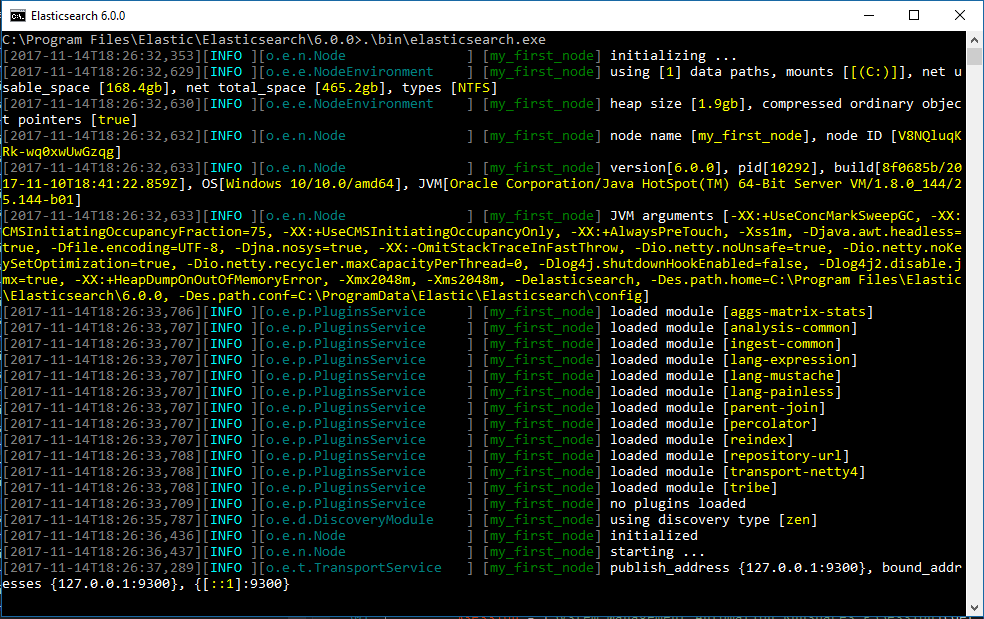
By default Elasticsearch prints its logs to STDOUT and to the <cluster name>.log
file within LOGSDIRECTORY. Elasticsearch logs some information while it is starting
up, but once it has finished initializing it will continue to run in the
foreground and won’t log anything further until something happens that is worth
recording. While Elasticsearch is running you can interact with it through its HTTP
interface which is on port 9200 by default. To stop Elasticsearch, press Ctrl-C.
Configuring Elasticsearch on the command line
editElasticsearch loads its configuration from the %ES_PATH_CONF%\elasticsearch.yml
file by default. The format of this config file is explained in
Configuring Elasticsearch.
Any settings that can be specified in the config file can also be specified on
the command line, using the -E syntax as follows:
.\bin\elasticsearch.exe -E cluster.name=my_cluster -E node.name=node_1
Values that contain spaces must be surrounded with quotes. For instance -E path.logs="C:\My Logs\logs".
Typically, any cluster-wide settings (like cluster.name) should be
added to the elasticsearch.yml config file, while any node-specific settings
such as node.name could be specified on the command line.
Checking that Elasticsearch is running
editYou can test that your Elasticsearch node is running by sending an HTTP
request to port 9200 on localhost:
GET /
which should give you a response something like this:
{ "name" : "Cp8oag6", "cluster_name" : "elasticsearch", "cluster_uuid" : "AT69_T_DTp-1qgIJlatQqA", "version" : { "number" : "7.14.2", "build_flavor" : "default", "build_type" : "tar", "build_hash" : "f27399d", "build_date" : "2016-03-30T09:51:41.449Z", "build_snapshot" : false, "lucene_version" : "8.9.0", "minimum_wire_compatibility_version" : "1.2.3", "minimum_index_compatibility_version" : "1.2.3" }, "tagline" : "You Know, for Search" }
Installing Elasticsearch as a Service on Windows
editElasticsearch can be installed as a service to run in the background or start automatically at boot time without any user interaction. This can be achieved upon installation using the following command line options
-
INSTALLASSERVICE=true -
STARTAFTERINSTALL=true -
STARTWHENWINDOWSSTARTS=true
Once installed, Elasticsearch will appear within the Services control panel:
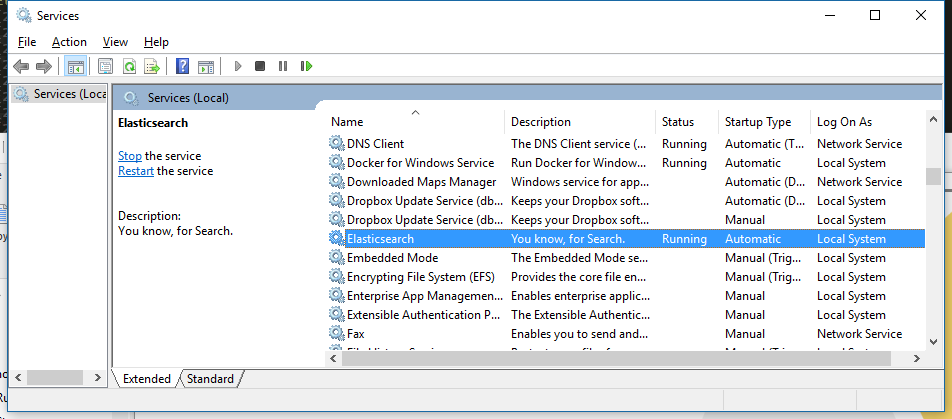
and can be stopped and restarted from within the control panel, or from the command line using:
with Command Prompt:
sc.exe stop Elasticsearch sc.exe start Elasticsearch
with PowerShell:
Get-Service Elasticsearch | Stop-Service Get-Service Elasticsearch | Start-Service
Changes can be made to jvm.options and elasticsearch.yml configuration files to configure the
service after installation. Most changes (like JVM settings) will require a restart of the
service in order to take effect.
Upgrade using the graphical user interface (GUI)
editThe .msi package supports upgrading an installed version of Elasticsearch to a newer
version. The upgrade process through the GUI handles upgrading all
installed plugins as well as retaining both your data and configuration.
Downloading and double-clicking on a newer version of the .msi package will launch the GUI wizard.
The first step will list the read-only properties from the previous installation:
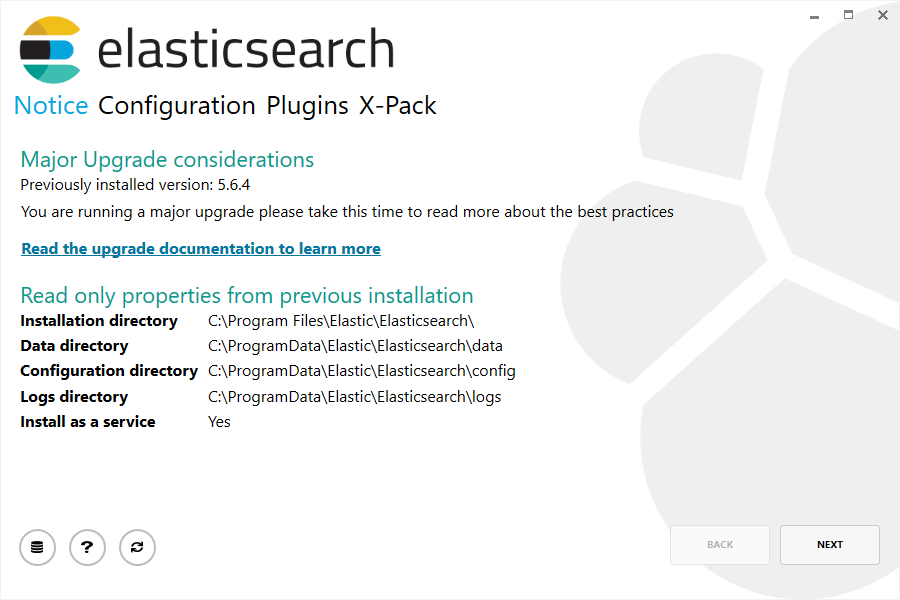
The next step allows certain configuration options to be changed:
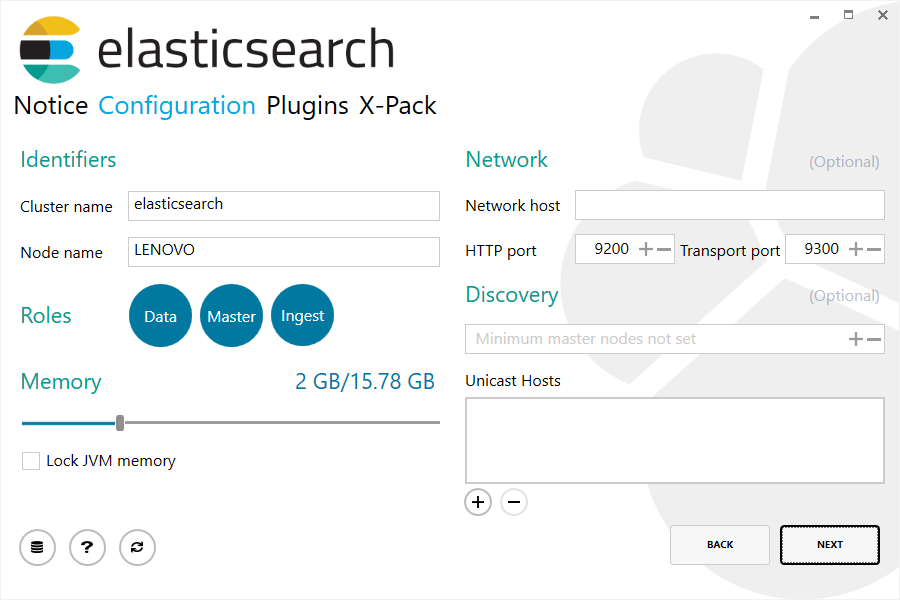
Finally, the plugins step allows currently installed plugins to be upgraded or removed, and for plugins not currently installed, to be downloaded and installed:
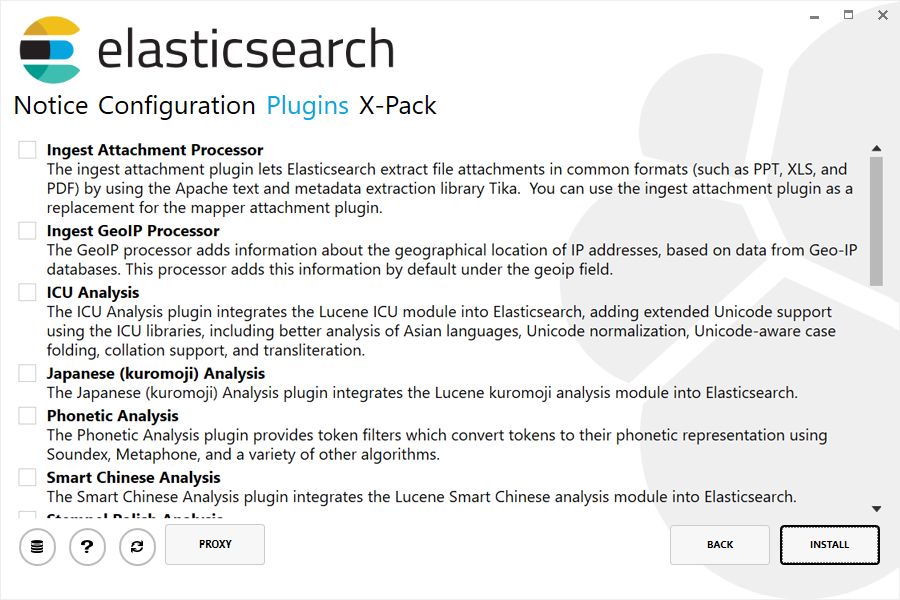
Upgrade using the command line
editThe .msi can also upgrade Elasticsearch using the command line.
A command line upgrade requires passing the same command line properties as used at first install time; the Windows Installer does not remember these properties.
For example, if you originally installed with the command line options PLUGINS="ingest-geoip" and
LOCKMEMORY="true", then you must pass these same values when performing an
upgrade from the command line.
The exception to this is the INSTALLDIR parameter (if originally specified), which must be a different directory to the
current installation.
If setting INSTALLDIR, the final directory in the path must be the version of Elasticsearch e.g.
C:\Program Files\Elastic\Elasticsearch\7.14.2
The simplest upgrade, assuming Elasticsearch was installed using all defaults, is achieved by first navigating to the download directory, then running:
start /wait msiexec.exe /i elasticsearch-7.14.2.msi /qn
Similar to the install process, a path to a log file for the upgrade process can
be passed using the /l command line argument
start /wait msiexec.exe /i elasticsearch-7.14.2.msi /qn /l upgrade.log
Uninstall using Add/Remove Programs
editThe .msi package handles uninstallation of all directories and files added as part of installation.
Uninstallation will remove all contents created as part of installation, except for data, config or logs directories. It is recommended that you make a copy of your data directory before upgrading or consider using the snapshot API.
MSI installer packages do not provide a GUI for uninstallation. An installed program can be uninstalled
by pressing the Windows key and typing add or remove programs to open the system settings.
Once opened, find the Elasticsearch installation within the list of installed applications, click
and choose Uninstall:
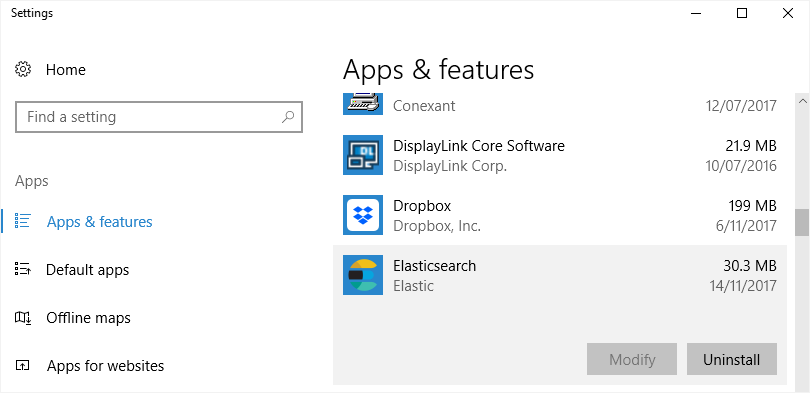
This will launch the uninstallation process.
Uninstall using the command line
editUninstallation can also be performed from the command line by navigating to the directory
containing the .msi package and running:
start /wait msiexec.exe /x elasticsearch-7.14.2.msi /qn
Similar to the install process, a path to a log file for the uninstallation process can
be passed using the /l command line argument
start /wait msiexec.exe /x elasticsearch-7.14.2.msi /qn /l uninstall.log
Next steps
editYou now have a test Elasticsearch environment set up. Before you start serious development or go into production with Elasticsearch, you must do some additional setup:
- Learn how to configure Elasticsearch.
- Configure important Elasticsearch settings.
- Configure important system settings.
On this page
- Download the
.msipackage - Install using the graphical user interface (GUI)
- Install using the command line
- Command line options
- Enable automatic creation of system indices
- Running Elasticsearch from the command line
- Configuring Elasticsearch on the command line
- Checking that Elasticsearch is running
- Installing Elasticsearch as a Service on Windows
- Upgrade using the graphical user interface (GUI)
- Upgrade using the command line
- Uninstall using Add/Remove Programs
- Uninstall using the command line
- Next steps